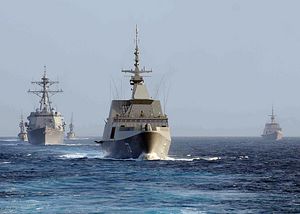How do we know when we’re faced with a salami slicing strategy? Ryan Martinson has recently reviewed Linda Jakobson’s work on the bewildering complexity of China’s maritime complex. Similarly, Jon Solomon has discussed some solutions of the problems associated with a salami slicing strategy. Solving the complex problem of salami slicing depends, to great extent, on our ability to recognize such a strategy.
Salami slicing works best against a coalition of states with uncertain levels of commitment. It identifies extended deterrence commitments as the vulnerable ligaments that hold a coalition together, and tries to place stress on those connections. Salami “slices” have greater strategic than intrinsic value, although the “slicer” can take advantage of differences in how the opposing coalition values particular objects.
Salami slicing requires long range planning, careful assessment of the commitment of an opponent. If an opponent is more interested in an excuse for aggression than in deterrence, then slicing can result in catastrophe. If the slices are too large, the effort can produce counter-balancing.
While the term “salami slicing” can refer to any effort to undermine conventional deterrence, it’s most commonly been used in reference to the attempts of authoritarian states to undermine the coherence of a coalition. The classic salami slicing moment came between 1933 and 1939, when Nazi regime undertook a series of small steps geared toward breaking the cage created by the Entente at Versailles. Thomas Schelling warned that the Soviets might try a similar strategy to break the unity of NATO in Europe.
This makes the term particularly appropriate for China, which appears to be trying to salami slice its way to dominance in the East and South China Seas. But as Jakobson points out, it’s easy to overstate the coherence of authoritarian foreign policy systems. What if salami slicing results not from a coherent, long range strategic plan, but more from an inability to manage the exigencies of the moment? Earlier this year in Ukraine, it appeared that Vladimir Putin had successfully pursued a salami slicing strategy, gaining control of large swaths of the country and undermining the unity of NATO. Now, facing a collapsing economy and an apparently rejuvenated NATO, it looks as if Putin stumbled into a situation he could not hope to manage.
Whether Putin was salami slicing, or simply trying to manage a dangerous coalition of domestic hardliners and Ukrainian militias may not have mattered much for NATO decision-making (although it may affect how we evaluate the Obama administration’s cautious approach). But determining the past and future coherence of Chinese assertiveness matters a lot. Steps taken to enhance our ability to respond to salami slicing (making the coalition coherent and responsive through coast guards, maritime militias, and so forth) can lead to dangerous escalation when not understood in proper context.
































